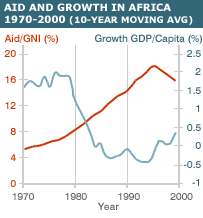This graph is very interesting. It tracks the degree of political polarization over time and plots it against the Gini coefficient, which is a measure of income inequality in a country. Develop Economies frequently references the Gini coefficient when discussing repressive kleptocratic regimes in Africa like Equatorial Guinea. Only recently, however, has he begun examining poverty in the United States. And he is not alone – even the hippies have managed to put down their bongs long enough to protest rising inequality in the country in the Occupy Wall Street protests.
People typically think of developing countries as having extraordinary disparities between the rich and poor, simply because, in places like India, Africa, and Asia, the poor are actually very poor. But in the United States, that gap is just as large or larger than some nations. It only seems that we are more equal because, as the Heritage Foundation is quick to point out, 99.6% of the so-called “poor” in the United States have a refrigerator (and 27.5% have more than one VCR!). Here is a more tangible example:
According to newly released data from the Census Bureau, greater Bridgeport has the widest gap between the rich and poor of 516 metropolitan and micropolitan areas included in the survey.
What does that mean in practical terms? The top 20 percent in the Bridgeport area — which includes Fairfield County, one of the wealthiest areas in the United States — took home nearly 60 percent of its income, while the bottom 20 percent took home 2.5 percent of the region’s money. In this nexus of billion-dollar hedge funds and bombed-out housing projects, the top 5 percent raked in a mean income of $685,000, while the bottom 20 percent’s mean income totaled less than $15,000.
To put that in perspective, if the Bridgeport metro area were a country, it would rank 12th from the bottom in the world for economic equality — lower than Mexico, Papua New Guinea and Zimbabwe.
The standard measure for comparisons is the Gini index — a 100-point scale where a 100 score indicates a country where all the income goes to one person and a zero score would be a country that divides up everything equally. Bridgeport’s Gini score is a 54, compared with 47 for the United States as a whole. By comparison, Russia’s score is 42, the United Kingdom’s is 34 and Germany’s is 27.
In other words, our poor don’t typically do not live in slums like Kibera without access to running water, toilets, electricity, or, in many cases, more than one room for entire families. But that doesn’t mean that southeastern Connecticut isn’t more unequal than Robert Mugabe’s Zimbabwe (it is).

The gap between the United States’ rich and poor continued to grow last year, according to new government wage data.
With pay down and fewer jobs available, the Social Security Administration’s figures highlight one of the major issues of the Occupy Wall Street movement – widening income disparity, the Associated Press reported.
The SSA said 50 percent of workers made less than $26,364 last year — and most Americans have fewer job opportunities available to them. But the wealthiest Americans are relatively unscathed, with those earning $1 million or more jumping 18 percent from 2009.
Total employment fell again last year, dropping from 150.9 million in 2009 to 150.4 million in 2010. And in 2007, at the height of the recession, there were still 5.2 million more jobs than in 2010, the AP wrote.
The average income for Americans was $39,959 last year, but the median wage was just $26,364. The SSA wrote that this shows “the distribution of workers by wage level is highly skewed,” the AP reported.
For those unfamiliar with statistics, the median is the middle number in a series – in this case, the median income is $26,364. In a normal distribution, the median equals the mean. So when the mean is nearly 33% higher than than the median, as it is in this case, you know that there are lots and lots of people struggling to get by while others continue to do extraordinarily well financially.

Image Credit: Damon Winter/New York Times
This is the issue at the heart of the Occupy Wall Street protests. But, looking at the chart, the level of polarization in government began back in 1980, with the election of Reagan and the beginning of the conservative revolution. So, while we are in the midst of an unprecedented failure of democracy, it seems to be precipitated by a lot of different factors that have played out over the last 30 years. I am not sure why this has happened, but I will venture a few guesses.
Maybe this happened because, as the rich get richer, the plough more money into influencing the political process in their favor. Lobbyists – an institutionalized and legal form of corruption – gain a disproportionate influence over policy-making, which creates a positive feedback loop of favorable legislation and tax loopholes for the certain industries – agriculture and financial services, to name a few. But, in a democracy, the people should be able to speak their voice at the ballpt box and ensure that their interests are represented by the politicians they elect to office. So how does such a small group of very wealthy individuals maintain their influence over the political process?
A few ways. First and foremost is money. You can bankroll legislation to marginalize voters, or give tons of money to political campaigns, which are increasingly expensive. As candidates spend more and more, an arms race develops that gives money greater ability to influence elections. In an op-ed titled “The Paradox of the New Elite,” Alexander Stille examines the relationship between inequality in the social and economic spheres, and how, in some senses, they are, if not mutually exclusive, at least move along a different trajectory:
Inequality has traditionally been acceptable to Americans if accompanied by mobility. But most recent studies of economic mobility indicate that it is getting even harder for people to jump from one economic class to another in the United States, harder to join the elite. While Americans are used to considering equal opportunity and equality of condition as separate issues, they may need to reconsider. In an era in which money translates into political power, there is a growing feeling, on both left and right, that special interests have their way in Washington. There is growing anger, from the Tea Party to Occupy Wall Street, that the current system is stacked against ordinary citizens. Suddenly, as in the 1930s, the issue of economic equality is back in play.

"You will vote for us."
When people are struggling financially, they tend to spread the blame across different groups – immigrants, minorities, labor unions on the right, and big business on the left. These baser instincts can then be exploited. That is why those at the top of the economic pyramid make social issues a part of the political package, bringing in the social conservatives who are unwilling to compromise on issues like abortion and gay marriage.
If you look at the most recent Republican presidents prior to 1980, they make today’s GOP politicians look like Barney Frank. Nixon created the EPA, for Pete’s sake. Reagan raised taxes 11 times during his administration. In contrast, when presented with a deficit reduction bill with a 10:1 ratio of spending cuts to tax increases, not a single Republican candidate went for it.
But this marriage of convenience between social and fiscal conservatives was ill-fated. As the social conservatives gained more power within the movement, they began to make their own demands. And unlike other voters, they are unwilling to compromise on their core values. Abortion is murder – period. Two men getting married is like a man marrying his dog – period. In an ad posted on YouTube, Bill Kristol posted an ad conflating anti-Semitism and anti-Israel sentiments with protests about income inequality. If you oppose “too big to fail,” you are anti-Semitic, necessarily.
Abortion is, by far, the biggest political weapon in the arsenal. The other day, Herman Cain, the hilarious frontrunner, in a moment of honesty, stated he was pro-choice. 12 hours later, he released a one-sentence statement:
I’m 100% pro-life. End of story.
Even Reagan supported an amnesty policy for illegal immigrants who had made the United States their home for many years. Today, the party of Reagan passed the harshest immigration law in Alabama in this country’s history. And now, they are paying the price:
Farmers are already worrying that with the exodus, crops will go unpicked. Like much of the rest of the country, Alabama needs immigrant labor, because too many native-born citizens lack the skill, the stamina and the willingness to work in the fields — even in a time of steep unemployment.
The new law has also added frustrating layers of paperwork for Alabamans who must now prove legal status when enrolling schoolchildren, signing leases and interacting with government. After the law went into effect, the lines at the Department of Motor Vehiclesin Birmingham grew so long that officials had to bring in portable toilets.
Alabama’s reputation has also taken a huge hit just when it is trying to lure international businesses. No matter how officials may try to tempt foreign automakers, say, with low taxes and wages, the state is already infamous as a regional capital of xenophobia.
This trend exemplifies the counterproductive economic effects of socially conservative policies. Who else is going to pick those onions – Herman Cain? I don’t think so.
Not as a mobile as we thought
Another thought comes from Scientific American, which tries to understand why support for income redistribution has actually declined during the recession:
What might explain this trend? First, the change is not driven by wealthy white Republicans reacting against President Obama’s agenda: the drop is if anything slightly larger among minorities, and Americans who self-identify as having below average income show the same decrease in support for redistribution as wealthier Americans.
Our recent research suggests that, far from being surprised that many working-class individuals would oppose redistribution, we might actually expect their opposition to rise during times of turmoil – despite the fact that redistribution appears to be in their economic interest. Our work suggests that people exhibit a fundamental loathing for being near or in last place – what we call “last place aversion.” This fear can lead people near the bottom of the income distribution to oppose redistribution because it might allow people at the very bottom to catch up with them or even leapfrog past them.
That is interesting. There are so many layers of this graph to unpack that I am not even sure what conclusions to draw. But I chose to title this post “Up and Out” because the first thing I thought of when I saw this chart is the final scene of Charlie and the Chocolate Factory, when Willy Wonka tells Charlie to push the button labeled “Up and Out.” The glass elevator then accelerates to incredible speeds and bursts through the ceiling and into the atmosphere. I see the political discourse and income inequality in this country following a similar trajectory. When does it plateau? Does it ever plateau? Have we entered a new era of globalization where 50% of the country is destined to earn less than $27,000 per year for eternity? Or will we have some kind of revolution where the natural order is restored and we return to the times before what Paul Krugman calls “the Great Divergence”?
The other day, long-time reader Ed, who recently adopted a baby boy (congratulations), commented that I my posts have diverged from the more typical market-driven development topics I previously wrote about. I certainly haven’t abandoned that angle – I hope to write many more posts about education, energy, microfinance, and social enterprise – but I am exploring other causes of poverty. That is why my last few posts focused on foreign policy and its effects on the development of different regions of the world. And the widening income gap in the United States also strikes me as an interesting case study in the role of government in reinforcing the poverty cycle. Further down the rabbit hole, things get more and more complex.
By venturing into the political discourse, I risk showing my cards. But these are important issues that fit in the broader context of this blog, which explores the root causes and, more frequently, potential solutions to poverty. But, in deference to Ed and others, I will soon return to my bread and butter and talk about the role of primary education in expanding opportunities for the poor.
(h/t Andrew Sullivan)
DEVELOP ECONOMIES MUSIC RECOMMENDATION
 My intention isn’t to say that everyone with a masters degree in international development and a resume overflowing with public sector and development experience is wrong about everything. Clearly, that experience is valuable in understanding context and knowing what has worked and not worked in the past. It is particularly relevant in the policy sphere – designing programs like
My intention isn’t to say that everyone with a masters degree in international development and a resume overflowing with public sector and development experience is wrong about everything. Clearly, that experience is valuable in understanding context and knowing what has worked and not worked in the past. It is particularly relevant in the policy sphere – designing programs like 


 This is the most important tenet of all. In Iraq, the U.S. overthrew Saddam and remarkably never planned for phase two. In Libya, all possible post-Gaddafi scenarios were taken into account to understand exactly what we were getting ourselves into. Not too far from where I live in Kenya, Obama
This is the most important tenet of all. In Iraq, the U.S. overthrew Saddam and remarkably never planned for phase two. In Libya, all possible post-Gaddafi scenarios were taken into account to understand exactly what we were getting ourselves into. Not too far from where I live in Kenya, Obama 




 The Pew Research Center just
The Pew Research Center just
 I call these views counterproductive because the policy prescriptions literally do more harm than good. Georgia just passed a law mandating that all businesses with more than 10 employees must demand to see indentification to prove that the workers are not here illegally. So what happened? All the illegal immigrants who used to be the backbone of the agriculture sector simply moved elsewhere, leaving farmers without laborers to harvest their crops. Here is the
I call these views counterproductive because the policy prescriptions literally do more harm than good. Georgia just passed a law mandating that all businesses with more than 10 employees must demand to see indentification to prove that the workers are not here illegally. So what happened? All the illegal immigrants who used to be the backbone of the agriculture sector simply moved elsewhere, leaving farmers without laborers to harvest their crops. Here is the 

